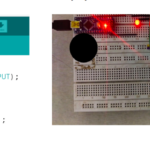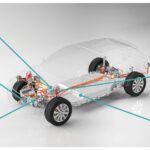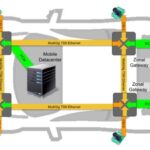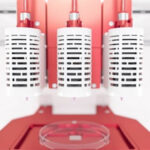 Horizontal mount screw machine pin-and-socket receptacle interconnects sit parallel to the surface of a printed circuit board. One reason why they’re so advantageous from a product design standpoint is that their mating centerline is low profile to the PCB. These horizontal mount interconnects can come in two configurations: surface-mount and right-angle through-hole.
Horizontal mount screw machine pin-and-socket receptacle interconnects sit parallel to the surface of a printed circuit board. One reason why they’re so advantageous from a product design standpoint is that their mating centerline is low profile to the PCB. These horizontal mount interconnects can come in two configurations: surface-mount and right-angle through-hole.
The primary advantage of surface mount horizontal interconnects is that they allow the product designer to use both sides of the identical location on a PCB. This doubles the packaging density.
 Two common versions of horizontal mount interconnects include: the barrel and S-Bend tail. The advantage of the barrel style interconnect is that it only requires a small PCB footprint. The advantage of the S-Bend tail is that it allows for greater visibility of the solder joint for inspection and accessibility for rework. Both SMT versions can be packaged on tape and reel.
Two common versions of horizontal mount interconnects include: the barrel and S-Bend tail. The advantage of the barrel style interconnect is that it only requires a small PCB footprint. The advantage of the S-Bend tail is that it allows for greater visibility of the solder joint for inspection and accessibility for rework. Both SMT versions can be packaged on tape and reel.
Typically horizontal SMT connectors should exhibit no greater than 0.005 in. variation of coplanarity over a 1 in. strip length. For strips longer than 1 in., the actual coplanarity will need to be determined.
 The primary advantage of through-hole right angle tail interconnects is that they are mechanically stronger than SMT connectors, as the pin tail is soldered inside a plated through-hole. It is now possible for even through-hole right angle tail interconnects to come on tape and reel too.
The primary advantage of through-hole right angle tail interconnects is that they are mechanically stronger than SMT connectors, as the pin tail is soldered inside a plated through-hole. It is now possible for even through-hole right angle tail interconnects to come on tape and reel too.
Mutual to both SMT and through-hole screw machine interconnects is their construction. Screw-machine receptacles are precision-machined using brass alloy. Screw machine socket receptacles are assembled with a progressive die stamping, made of Beryllium Copper, called a “Contact Clip.” Contact clips characteristically are configured in 3, 4, 6 and 8 multi-finger arrangements. The function of a contact clip is to provide the mechanical and electrical interface to the mating pin.
 Because contact clips are heat hardened during manufacturing, they score the surface of the mating pin. This achieves a reliable gas-tight connection. However, contact clips are not locking mechanisms for the mated pin. The pin can be pulled out when required. Contact clips come in a variety of pin acceptance ranges, each with its own characteristic force parameters.
Because contact clips are heat hardened during manufacturing, they score the surface of the mating pin. This achieves a reliable gas-tight connection. However, contact clips are not locking mechanisms for the mated pin. The pin can be pulled out when required. Contact clips come in a variety of pin acceptance ranges, each with its own characteristic force parameters.
The two-piece construction of precision screw machine socket receptacles allows for cost savings to be realized as the shell can be plated tin for improved solderability while the contact clip is plated gold for corrosion resistance. Plating gold only where required results in cost savings.
One little known trick of using horizontal mount interconnects, is to combine them with a vertical mount interconnect, which forms space saving, perpendicular orientation on the PCB.
 Another little known fact is that screw machine receptacles assembled with contact clips having a pin acceptance range of 0.030 in. diameter and 0.025 in. square posts, can effectively mate to common 0.025 in. square post header strips. This allows the product designer to create mating modules using square post headers with round screw machine socket receptacles.
Another little known fact is that screw machine receptacles assembled with contact clips having a pin acceptance range of 0.030 in. diameter and 0.025 in. square posts, can effectively mate to common 0.025 in. square post header strips. This allows the product designer to create mating modules using square post headers with round screw machine socket receptacles.
Horizontal mount screw machine interconnects are typically manufactured with RoHs compliant platings and thermoplastics suitable for RoHs soldering profiles. As this blog presented in detail, horizontal mount screw machine interconnects have many useful applications and present product designers with cost effective, low-profile solutions.
Martin Houlroyd is Principal Engineer/Marketing Specialist at Preci-Dip. He has worked in the interconnect industry for 35 years. Email him at m.houlroyd@precidip.com.
The post What are horizontal mount interconnects? appeared first on Connector Tips.






